CASE HISTORIES
The principles of unloading the hoof wall have been applied on countless cases in Sandy Loree's practice during and since the development of the 5S Equine Sole Support System. The early cases and the more severe cases were documented with detailed records, including photos and radiographs. There have never been any formal scientific studies but the records do detail treatments, procedures, results, observations and insights that were deemed pertinent at the time. Those records were invaluable during the development of the 5S components as well as management techniques and application procedures. A definite pattern of positive results emerged and the results cannot be ignored. Lately, cases have not been documented in such detail because the same pattern of positive results continues to be repeated. Over the years, other people have shared documentation and observations regarding interesting cases in their care. We learn something from each case. The 5S Management techniques continue to evolve with more efficient results.
It is safe to say that virtually every case experienced dramatic improvement to the quality of the hoof. The level of improvement is more than the mere 5%, 10%, or 20% as might be hoped for. Most of the cases were reclaimed to near normal condition and are subsequently easy to maintain at that condition. Eminent laminitis cases were prevented from foundering. Acute laminitis cases were managed to bring the inflammation under control. Chronic foundered cases returned to normal alignment and attachment of the hoof wall relative to P3, with a narrow, dense whiteline. Cracked hooves grew out free of cracks. Hooves with weak flared walls, with dished toe profile, with extended whiteline and with thin, dropped soles grew out displaying thicker, rigid, straight walls while the soles became thick, tough and resilient. Genetics and existing permanent tissue damage are the only factors that limit the rejuvenated hoof condition and the horses' performance. The cases that are described here, exhibit results typical of other cases.
There were cases that did experience complications in the form of sole bruises and abscesses. These complications must be expected and prepared for. They are painful to the horse and can be demanding to deal with at the time. However, the reader should know that in proportion to the number of cases involved, the long months of sole support application, and the overall benefit to the hoof, the occurrences of bruises and abscesses are merely minor inconveniences. Methods to avoid and manage complications of sole loading are discussed in the Manage Complication section.
GENERAL - HOOFWALL CRACKS
General was an eight year old bay Thoroughbred gelding. He was unsound with numerous deep hoof wall cracks on all four feet. The walls were flared with extended whiteline. The soles were thin and tender. The left front was the sorest with a deep crack that extended up into the coronary band at the toe. The left hind had a similar complete crack at the lateral quarter.
General was a gift to the present owner. He had been in this condition for a few years, and was given little hope of recovery. Because he is gentle and quiet and could not get around very well, it was hoped he could at least provide some pleasure to the small children in the new family.
On June 29, 1997, General was fitted with 5S Eliminator pads on both front feet. The hind feet were trimmed with the 5S Short Wall trim. He was turned out in a soft pasture. The feet were trimmed and the support system was reset at five week intervals.
In the beginning, General continued to move quite slow and deliberate. His comfort level increased over the summer as the cracks sealed up at the hairline and the sole toughened up. He always traveled somewhat tender on the front but did manage to run once in a while.
The new growth progressed free of cracks. By early December, there was 1 ¾" of new solid wall. This wall appeared to be considerably thicker.
At this time, General became sore on the right front. The sole support system was removed. He would still bear weight on the foot but was tender all around the sole area. The right front foot was poulticed on a twenty-four basis for five days until the drainage stopped. The pain subsided as the fluids were eliminated. After the drainage stopped that foot was kept in a protective boot with a dry packing for an additional four days. By mid December, General was traveling well. By now there was a good snow cover on the ground so he was turned out barefoot. At the next trimming the fronts were trimmed short like the hinds and the trimming frequency was maintained at five week intervals.
Through the winter, General became very sound with much running and playing in the snow. As of the end of February, there is a full 2 ½" of new growth free of cracks. The profile of the new wall is straight and the angles are upright. The soles are thick and tough. The bars and heels are strong. It appears that General has excellent quality hooves for a Thoroughbred.
By summer, General is ready and able to be used to full capacity. He is lucky enough to be located in an area where the ground turf is quite soft and should function well barefoot. The down side of this story is that General is now too much horse for the small children. He has been sold to a new owner and moved on to a new career.
RED'S RECOVERY FROM LAMINITIS (By Cody Sayles)

A reward was offered in the spring of 2000 for the most interesting report on a laminitis or hoof wall crack case that was treated using 5S Sole Support techniques. Cody's submission was chosen because it made interesting reading and his documented observations and experiences are typical of those encountered by others. Cody is to be congratulated on a job well done. Cody is a graduate of the Farrier Science Program at Olds College (Olds, Alberta, Canada). He currently operates his farrier business out of Vanderhoof, British Columbia, Canada.
Red is a sixteen year old red roan Quarter Horse gelding. He is owned by Lorne and Mona Himech and family. They live on a ranch near Houston, in northern British Columbia, in western Canada. Red was purchased as a six year old and used for ranch work, team roping and barrel racing. Because of Red's solid build, speed and great mind, he was a joy to ride and excelled in his events. However, he was only usable for three to four months a year.
Red suffered from a chronic foundered condition. He would be quite sound over the winter months, but by mid-summer, or his third shoeing of the year, Red was lame and unusable. This was an annual occurrence until he was retired to pasture at the ripe old age of eleven.
Figures 2  and 3
and 3 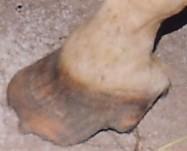 taken on August 22, 2000, show the condition of Red's front feet when treatment was initiated. The white-line measured one inch at the toe. The sole was flat and tender with much evidence of bruising. Red traveled with extremely short strides and was quite lame. He stood with his hind feet far up under himself. The initial shoeing proved to be a strenuous task because Red was unable to stand on one foot for very long.
taken on August 22, 2000, show the condition of Red's front feet when treatment was initiated. The white-line measured one inch at the toe. The sole was flat and tender with much evidence of bruising. Red traveled with extremely short strides and was quite lame. He stood with his hind feet far up under himself. The initial shoeing proved to be a strenuous task because Red was unable to stand on one foot for very long.
Red's treatment involved the application of the 5S Equine Sole Support System and associated techniques. In Red's case the Supporter pad was chosen.
August 22, 2000 was the first application of the 5S System. I avoided paring away the thin sole. I lowered the heels and backed up the toe. Being a green horn just out of farrier school and this my trial run using the 5S System I was unsure how to shape the Supporter pad and how to mix and install the Insole putty. With Lorne's help, we made frequent reference to the enclosed instructions throughout the procedure and we managed just fine.
Figures 4 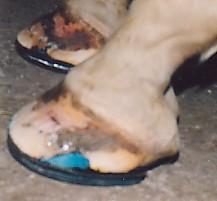 and 5
and 5  show the left front after the 5S Insole and Supporter pad are installed.
show the left front after the 5S Insole and Supporter pad are installed.
October 4, 2000 marked six weeks of Red wearing the 5S pads when we reset his shoes. It appeared all that had grown was from the last nail hole back, therefore I lowered the heels and backed his toe up more. We installed new Insole putty and reset the shoes and pads.
We noticed a major growth ring one half inch down from the coronet band. The new hoof wall growth above this line appeared to be following parallel with the profile of the coffin bone.
December 5, 2000. Due to the colder weather and lack of growth in the late fall, we allowed Red to wear his shoes for nine weeks. As before, I backed his toe up as much as possible and took his heels back to the widest part of the frog. What I saw when I looked at the sole of Red's feet were pink areas and bruises which suggested that his sole was thin and there still was no need to pare any away. The problem was that Red's feet looked long. Most horse owners would simply tell me to "stand him up" but I was quite confident that was not the solution to Red's condition.
The biggest difference was that Red now traveled like any other sound horse. He now stood square and was able to stand on one front foot without discomfort.
February 10, 2001 marked another nine-week term for Red. As with the previous shoeings, there appeared to be little growth on the ground surface. I again backed up the toe and lowered the heels as far as I could. What I noticed was how the nail holes from October were not very far from where I was trying to drive new nails. I really would have liked to make his feet shorter but I continued to see the same signs in Red's sole as the previous reset. I also thought of the directions included with the 5S System where it stated "avoid paring away any more sole than is necessary", and I was trying to continue with what was best for Red.
April 24, 2001 marked eleven weeks since Red's last shoeing. After much discussion, Lorne and I agreed that a change was greatly needed because Red was walking on stove-pipe looking feet. For some strange reason it did not click with me until this point that, because the bottom of the feet were covered, the sole could not exfoliate like it would on a normal foot. The sole had gone from the point of not having much thickness to being too thick. Red was wearing eight months of sole between his feet and the pads. It appears that I took one part of the instructions too literally.
What continued to deter me from paring the sole very much before were the blood pockets and soft spots. However, as I carved through an inch of sole, I found numerous old bruises and corns, that were not remotely close to any living tissue. It was hard work because the sole was very solid and dense and tough to cut through. Underneath this thick sole callous I encountered familiar exfoliated chalky white sole.
Figure 6 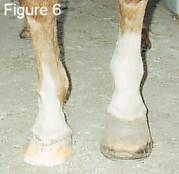 shows the difference in the feet after a proper trim. It was after this shoeing that I was much more satisfied with the job. The heels are finally taken back to support the bony column of the leg. The hoof wall and pastern angles are the same where previously the axis was always slightly broken.
shows the difference in the feet after a proper trim. It was after this shoeing that I was much more satisfied with the job. The heels are finally taken back to support the bony column of the leg. The hoof wall and pastern angles are the same where previously the axis was always slightly broken.
Two weeks after I reset Red he came up lame. Lorne pulled the shoe and found an abscess close to, but slightly back from the point of the frog. He linked this abscess to a small horizontal crack in the back of one of the bulbs on Red's foot. Whether it was a small rock that punctured this spot or some existing bacteria that caused this abscess, we do not know. The path was traced to the point of the frog with the aid of a narrow oil spout. The spout could be easily pushed into the crack at the bulb all the way to the abscess point without any discomfort to our patient.
After one week of Red wearing a medicine boot filled with Forshners hoof packing and having his foot cleaned and soaked daily, Lorne nailed the shoe and pad back on.
June 2001 - I was back to reset Red's shoes again. What I found when I exposed the bottoms of the feet was a complete false frog. I literally removed it with my finger tips. This was not the same as any other horse just shedding his frog because what was underneath was not a normal developed frog. It was perhaps only one third the size of a normal frog and extremely soft. To ensure Red's feet were as close to bacteria-free as possible, I decided to take a chance and pare away everything that did not bleed for fear that any missed bacteria could cause an abscess again. Even with the soft soles, Red never took a lame step and continued down the trail of improvement.
July 24, 2001 I again traveled to Houston for Red's appointment. It has been a full eleven months of wearing the 5S pads and I am happy to see his feet continually improve.
Figure 7 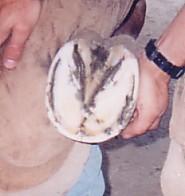 shows the bottom surface of the right front foot while Figure 8
shows the bottom surface of the right front foot while Figure 8 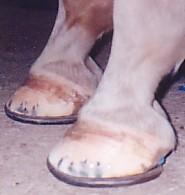 shows Red's front feet while standing. At this point it is the poorest of the two feet, however compared to the before pictures this foot is close to perfection. There is still a minor separation in the toe but I am confident this will be completely trimmed out with the next reset. All the structures that were previously affected appear to be fully repaired and growing like any other normal foot.
shows Red's front feet while standing. At this point it is the poorest of the two feet, however compared to the before pictures this foot is close to perfection. There is still a minor separation in the toe but I am confident this will be completely trimmed out with the next reset. All the structures that were previously affected appear to be fully repaired and growing like any other normal foot.
August 22, 2001 will mark one full year of applying the 5S System on Red. The results are phenomenal.
In early September, when Red is due to be reset, I plan on again applying the pads. The reason for this is that I am unsure how susceptible to the mechanical tearing his feet will be because of past history and I do not want to remove the pads too soon and possibly hurt his progress at this point.
CONCLUSION
I am amazed by the changes I have witnessed with Red in the last year. Other than being the same colour, Red is not the same horse. Compared to how he traveled and stood before and how he travels now is the difference between night and day. He now travels completely sound. Because of the 5S Equine Sole Support System and persistence, Red is again usable for riding and still has many years ahead of him.
I would personally like to commend Sandy Loree on the idea and development of the 5S System. As someone who has been able to apply this system and see the staggering difference it has made in Red's case, I feel that Sandy is a valuable member to have in the Farrier profession and feel privileged to have been associated with him and be able to learn from him.
I would also like to thank Lorne and Mona Himech for all of their devotion towards this project. I think it is a great thing to be able to work with someone who was as eager to see improvements and new results as I was. Lorne spent many hours on this project and never complained of the cost or any of the minor set backs we encountered throughout the year.
I feel that this was a trial and error task from the beginning and we definitely learned from our mistakes. At times, I probably did not give Red 100% of what he needed but he still progressed very well. You live and learn along the way.
I hope that whoever reads this case study has enjoyed it and has found some useful information that may help understand more about fixing problems of the equine foot.
Thank you and happy trails.
GEORGE'S STORY - LAMINITIS - January 2000
George is a liver chestnut grade Quarter Horse gelding in his late teens. He was a team cattle penner for most of his life and had been enjoying semi-retirement for the past two years. George is a calm, easy going guy and had become somewhat overweight, as is common with geldings of this type when the physical activity is reduced, plus the owner likes him chubby. He was overweight for performance but did not display the typical thick neck crest and body cellulite associated with laminitis.
In late January 1999, George developed mild lameness symptoms. Looking back, I believe George was observed in the early developmental stage of laminitis. At the time, the situation was unclear. His lameness symptoms indicated laminitis, but many symptoms that are consistent with laminitis had not yet developed. The digital pulse was normal. There was no noticeable heat. No sunken hairline. The sole responded normal to squeezing with hoof testers. There had not been an obvious systemic condition other than the weight problem that might have triggered the laminitis episode. For financial reasons, no formal veterinary examination was done.
Previous experience with other cases had taught me that the best insurance against founder is to unload the wall right away. The heels were lowered somewhat to position the ground surface of P3 to be level with the ground. All four feet were trimmed with a mild short wall trim. That is, the wall was trimmed level with or shorter than the sole callous. None of the sole callous, bars nor frog was removed. This minimized the wall contacting the ground, leaving the laminae relatively unloaded. The horse was turned out and given 2 gm of "Phenylbutazone" daily for 10 days.
George responded OK at first. He displayed some relief from the hoof lameness and improved daily. It just so happened, in that period of the winter, there was not much snow cover. After about three weeks on the frozen ground, George became sole tender on both front feet.
I was still not convinced the problem was laminitis, so I chose to allow load back onto the laminae in order to treat the sole inflammation. The fronts were shod with light shoes complete with plastic pads and medicated hoof packing. George displayed relief from the sole tenderness but was still not traveling normal. Meanwhile between the confusion with the diagnosis and the owner's tendency to overfeed, nothing was done to reduce the horse's weight.
After three weeks with the shoes placing a high load on the laminae, George became very lame on both fronts with obvious founder symptoms and he chose to lie down much of the time. Now there was no doubt that the diagnosis was laminitis, but sadly the damage had been done.
The front feet were shod (March 1999) with "5S Insole and Supporter Pads" to achieve a 50% load share between the hoof wall and the sole. To address the sole inflammation problem and the expected buildup of serum fluids under the wall, a groove was cut through the hoof wall, about 1" above the ground in the toe region, exposing the insensitive laminae. A poultice, using "Animalintex", was applied to this groove and over the bulbs of the heels. Anti-inflammatory treatments were administered and the poultice was replaced daily. The owner was advised to reduce the horse's body weight.
Upon the installation of the sole support system, George was still very uncomfortable. He was observed lying down much of the time. The poultice pulled fluids for 10 days before the dressings stayed clean and dry. By then George was much more comfortable, spending much of his time on his feet. He traveled freely around the yard at a careful walk. The poultices were discontinued and the anti-inflammatory treatments were phased out after another week.
George's condition gradually improved. There was not much change from day to day but the improvement was noticeable with each passing month. He didn't suffer any major set backs. He did exhibit increased discomfort for a few days following each of the first few resettings. That was controlled with anti-inflammatory treatments during those days.
The sole support system was reset at 5 week intervals. The overall toe length was allowed to increase from 3 3/8" to 4 1/4" to a point where the estimated sole callous was approximately 3/4" thick. The heels were trimmed low to maintain P3 level with the ground. The white line, at its widest, measured 5/8" at the toe. The dorsal surface of the wall at the toe was rasped back to where the normal profile should be. The toe of the shoe was rockered slightly to place the break-over vertically below the tip of P3.
The major growth ring, that occurred on the hoof wall when the feet foundered, was used as a reference to track and measure the hoof wall growth. The ring moved 1/4" to 5/16" from the hairline in 5 weeks. The new wall generated above that ring is smooth and appears to have followed parallel with the surface of P3.
By the six month stage, the reference ring was approximately 1 1/2" from the hairline. George was not traveling completely sound, but was seen running and playing at times. Now that inflammation was under control, the shoe thickness was reduced from 5/16" to 1/4". This was done to further reduce the load on the laminae to maximize the healing potential. From then on, George was used for occasional light riding by a 12 year old child.
At the time of this writing (January 2000), George is doing excellent. The reference ring is about 2 3/4" from the hairline. The whiteline is becoming narrower. George travels normal. The feet are left bare foot. There is some snow cover. The sole callous is at least 3/4" thick and he exhibits no response to hoof testers over the sole area. I felt he could now handle natural sole support.
In hindsight, I regret not keeping the hoof wall unloaded for a longer time, in the beginning. It is probable the feet would not have foundered had the sole support been continued initially. I should have been proactive and more aggressive regarding the management of sole inflammation and the drainage fluids when sole tenderness first appeared. George's condition would have been simply resolved within one or two months.
By summer, George's front feet should be completely back to normal. The hinds have remained normal and sound. He still carries extra weight which may put him at risk for another laminitis episode. However, George is back.
CROOK – Prevented From Founder
Crook is a 5 year old Quarter Horse gelding. In the late summer of 1994, Crook was diagnosed with Potomac fever. He received veterinarian treatment shortly after the initial occurrence of diarrhea. Crook responded to the treatments and in three days was on the mend. But, within that time, laminitis symptoms appeared on the front. Crook was immediately shod with 5S Eliminator pads on the front and was trimmed short on the hind. We was turned out in a grassed paddock. The lameness symptoms associated with laminitis disappeared right away. Crook remained comfortable with regard to his feet as he regained his condition that was lost due to the fever. The 5S System was removed after three weeks. Crook has since remained sound with no sign of founder.
CAT – Hoof Wall Cracks
Cat is a 15 year old Quarter Horse gelding. He is used during the spring, summer and fall for ranch work and team roping. Cat's feet have naturally thin walls, The hind have stayed in good condition but the fronts have been plagued with deep wall cracks. The sole was somewhat dropped while the walls displayed a dished profile, flares and weak heels. Cat was kept reasonably functional with wide branched shoes, rocked toes and extended heels. There was never much growth on the ground surface. Trimming involved dressing away the flares and backing up the toes. There was not much solid wall to drive nails into. The shoes came loose within three to four weeks.
Each winter there was a notable improvement to Cat's hoof condition. He was left barefoot and turned out in the snow to winter graze. Come spring the new wall growth would have fewer cracks for about one inch below the hairline. However, when the hooves were shod again during the summer work season, the cracks would migrate back up to the hairline even when a horizontal groove had been cut at the top of the cracks. The cycle would be repeated each season and the hoof condition stayed chronic.
In the spring of 1996, Cat was shod on the front with the 5S System using Supporter pads. The 5S System was reset at 4 to 5 week intervals throughout the spring summer and fall. The shoe type varied from plain shoes with corks during calving season to rimmed shoes during the summer roping season. The toes were still backed up and the shoes had a rocked toe and extended heels.
Once the 5S System was installed, most of the cracks stabilized and did not migrate back up toward the hairline, leaving the new wall growth free of cracks. On or two of the major cracks, near the toes, still tended to work their way upward but did become progressively narrower. The hoof wall condition continued to improve over the summer. The new wall growth appeared to be thicker and faster. There were fewer flares to be dressed away and more actual wall length to be trimmed. The heels and bars became stronger. The sole became healthy, tough and concave. With progressive resettings, the shoes began to stay firmly attached for the 5 weeks. Meanwhile, Cat remained wound while carrying a full workload. He is under saddle three to five days a week in rough ranch conditions.
The winter of 1996-97 was long and cold with deep snow. Cat's feet were neglected without being trimmed from October until the end of February. The wall then displayed a straight profile, but there were still two cracks near the toe on both front feet. The 5S Supporter System was again installed and maintained over the summer. Three of the four cracks became dormant and steadily grew out. The one crack stubbornly moved upward during the wet spring season. Going into the dry part of the summer that crack was given a deep cross groove at the top. Finally it too gave up and the new wall growth stayed crack free.
All but the one crack had disappeared by winter time. Cat was again turned out barefoot, but this winter the trimming intervals have been five weeks apart with the walls trimmed quite short leaving the sole and bars untrimmed. Spring of 1998, the walls are straight and upright and the remaining crack is half way to the ground. Cat was again fitted with the 5S Supporter System when calving season started and the system was again continued throughout the summer. The cracks were virtually gone by winter turnout.
Cat's cracks probably could have been removed within one year if the 5S Eliminator pad had been used. However, he would have been laid of work for that year. Cat's feet have steadily improved without him missing a day's work.
Cat was kept shod in this manner for several years until his retirement. He remained sound and functional. Minor surface cracks would appear whenever the hoof care was lax or when the ground conditions were extreme.












